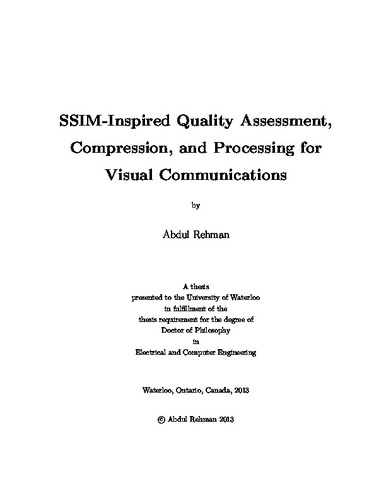UWSpace will be migrating to a new version of its software from July 29th to August 1st. UWSpace will be offline for all UW community members during this time.
SSIM-Inspired Quality Assessment, Compression, and Processing for Visual Communications
| dc.contributor.author | Rehman, Abdul | |
| dc.date.accessioned | 2013-08-29 14:38:22 (GMT) | |
| dc.date.available | 2013-08-29 14:38:22 (GMT) | |
| dc.date.issued | 2013-08-29T14:38:22Z | |
| dc.date.submitted | 2013 | |
| dc.identifier.uri | http://hdl.handle.net/10012/7763 | |
| dc.description.abstract | Objective Image and Video Quality Assessment (I/VQA) measures predict image/video quality as perceived by human beings - the ultimate consumers of visual data. Existing research in the area is mainly limited to benchmarking and monitoring of visual data. The use of I/VQA measures in the design and optimization of image/video processing algorithms and systems is more desirable, challenging and fruitful but has not been well explored. Among the recently proposed objective I/VQA approaches, the structural similarity (SSIM) index and its variants have emerged as promising measures that show superior performance as compared to the widely used mean squared error (MSE) and are computationally simple compared with other state-of-the-art perceptual quality measures. In addition, SSIM has a number of desirable mathematical properties for optimization tasks. The goal of this research is to break the tradition of using MSE as the optimization criterion for image and video processing algorithms. We tackle several important problems in visual communication applications by exploiting SSIM-inspired design and optimization to achieve significantly better performance. Firstly, the original SSIM is a Full-Reference IQA (FR-IQA) measure that requires access to the original reference image, making it impractical in many visual communication applications. We propose a general purpose Reduced-Reference IQA (RR-IQA) method that can estimate SSIM with high accuracy with the help of a small number of RR features extracted from the original image. Furthermore, we introduce and demonstrate the novel idea of partially repairing an image using RR features. Secondly, image processing algorithms such as image de-noising and image super-resolution are required at various stages of visual communication systems, starting from image acquisition to image display at the receiver. We incorporate SSIM into the framework of sparse signal representation and non-local means methods and demonstrate improved performance in image de-noising and super-resolution. Thirdly, we incorporate SSIM into the framework of perceptual video compression. We propose an SSIM-based rate-distortion optimization scheme and an SSIM-inspired divisive optimization method that transforms the DCT domain frame residuals to a perceptually uniform space. Both approaches demonstrate the potential to largely improve the rate-distortion performance of state-of-the-art video codecs. Finally, in real-world visual communications, it is a common experience that end-users receive video with significantly time-varying quality due to the variations in video content/complexity, codec configuration, and network conditions. How human visual quality of experience (QoE) changes with such time-varying video quality is not yet well-understood. We propose a quality adaptation model that is asymmetrically tuned to increasing and decreasing quality. The model improves upon the direct SSIM approach in predicting subjective perceptual experience of time-varying video quality. | en |
| dc.language.iso | en | en |
| dc.publisher | University of Waterloo | en |
| dc.subject | Structural Similarity | en |
| dc.subject | Image Quality Assessment | en |
| dc.subject | Video Coding | en |
| dc.subject | Video Quality Assessment | en |
| dc.subject | Image Processing | en |
| dc.subject | Image Denoising | en |
| dc.subject | Video Compression | en |
| dc.subject | Image Restoration | en |
| dc.subject | Perceptual Quality Optimization | en |
| dc.subject | Visual Communications | en |
| dc.title | SSIM-Inspired Quality Assessment, Compression, and Processing for Visual Communications | en |
| dc.type | Doctoral Thesis | en |
| dc.pending | false | en |
| dc.subject.program | Electrical and Computer Engineering | en |
| uws-etd.degree.department | Electrical and Computer Engineering | en |
| uws-etd.degree | Doctor of Philosophy | en |
| uws.typeOfResource | Text | en |
| uws.peerReviewStatus | Unreviewed | en |
| uws.scholarLevel | Graduate | en |

